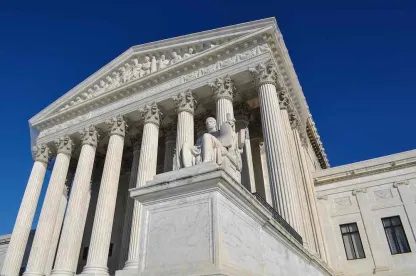On October 12, 2022, the Supreme Court of the United States heard oral arguments in a case regarding whether an oil rig worker who performed supervisory duties and was paid more than $200,000 per year on a day rate basis is exempt from the overtime requirements of the Fair Labor Standards Act (FLSA).
The case is especially significant for employers that pay exempt employees on a day rate. It could have a major impact on the oil and gas industry in the way that it recruits, staffs, and compensates employees who work on offshore oil rigs and at remote oil and gas work sites. In addition, depending on how the Supreme Court rules, its decision could have much broader implications.
During the arguments in Helix Energy Solutions Group, Inc. v. Hewitt, the justices questioned whether, despite the employee’s high earnings, he was eligible for overtime compensation because he was paid by the day and not on a weekly salary basis. There is no express statutory requirement that an employee be paid on a “salary basis” to be exempt from overtime requirements, but such a requirement has long been included in the regulations issued by the U.S. Department of Labor (DOL) applicable to the FLSA’s white-collar exemptions. Notably, Justice Brett Kavanaugh suggested during the arguments that the regulations may be in conflict with the text of FLSA, although Helix did not raise this issue in its petition for certiorari.
Background
The case involves an oil rig “toolpusher,” an oilfield term for a rig or worksite supervisor, who managed twelve to fourteen other employees, was paid a daily rate of $963, and earned more than $200,000 annually. Between December 2014 and August 2017, when Michael Hewitt was discharged for performance reasons, he worked twenty-eight-day “hitches” on an offshore oil rig where he would work twelve-hour shifts each day, sometimes working eighty-four hours in a week. After his discharge, Hewitt filed suit alleging that he was improperly classified as exempt and therefore was entitled to overtime pay. The district court ruled in favor of Helix.
In September 2021, a divided (12-6) en banc panel of the U.S. Court of Appeals for the Fifth Circuit held that Hewitt was not exempt from the FLSA because his payment on a day-rate basis did “not constitute payment on a salary basis” for purposes of the highly compensated employee (HCE) exemption that is found in the FLSA regulations.
The Fifth Circuit further concluded that the employer’s day-rate pay plan did not qualify as the equivalent of payment on a salary basis under another FLSA regulation because the guaranteed pay for any workweek did not have “a reasonable relationship” to the total income earned. In other words, the court found that the employee was not exempt because the $963 he earned per day was not reasonably related to the $3,846 the employee earned on average each week.
Oral Arguments
Oral arguments at the Supreme Court focused on the interplay between the DOL’s HCE regulation, 29 C.F.R. § 541.601, and another DOL regulation, 29 C.F.R. § 541.604(b), which states that an employer will not violate the salary basis requirement under certain limited circumstances even if the employee’s earnings are computed on an hourly, daily, or shift basis.
At the time of Hewitt’s employment, the HCE exemption required an employee to be paid at least $455 per week on a “salary or fee basis” and to earn at least $100,000 in total annual compensation. Those threshold amounts have since been increased to $684 per week and $107,432 per year.
The other regulation, 29 C.F.R. § 541.604(b), states that an employee whose earnings are “computed on an hourly, a daily or a shift basis” may still be classified as exempt if the “employment arrangement also includes a guarantee of at least the minimum weekly required amount paid on a salary basis regardless of the number of hours, days or shifts worked, and a reasonable relationship exists between the guaranteed amount and the amount actually earned. The reasonable relationship test will be met if the weekly guarantee is roughly equivalent to the employee’s usual earnings at the assigned hourly, daily, or shift rate for the employee’s normal scheduled workweek.”
Hewitt earned double the minimum total compensation level for the HCE exemption. Since the minimum salary level for the exemption was only $455 per week, and Hewitt was guaranteed that he would be paid at least $963 per week for each week he worked at least one day, Helix argued that he was exempt from the FLSA’s overtime requirements because the HCE exemption was completely self-contained and to be applied without regard to other regulations, including the “salary basis” test and the minimum guarantee regulation. Hewitt argued that the HCE exemption required compliance with either the “salary basis” test or the minimum guarantee regulation since he was admittedly paid on a day rate basis.
However, Justice Ketanji Brown Jackson suggested that it was not that simple. Justice Jackson said the question of salary basis is more about the “predictability and regularity of the payment” for each workweek. “What he has to know is how much is coming in at a regular clip so that he can get a babysitter, so that he can hire a nanny, so that he can pay his mortgage,” Justice Jackson stated. Justice Jackson echoed the language of the salary basis test requiring that an exempt employee be paid a predetermined amount for any week in which she performed any work.
Similarly, Justice Sonia Sotomayor asked Helix, “so what you’re asking us to do is take an hourly wage earner and take them out of 604, which is the only provision that deals with someone who’s not paid on a salary basis.” Justice Sotomayor additionally raised the FLSA’s goal of “preventing overwork and the dangers of overwork.”
In contrast, Justice Clarence Thomas suggested that Hewitt’s high annual compensation relative to the average worker is a strong indication that he was paid on a salary basis and should be exempt. “The difficulty is just, for the average person looking at it, when someone makes over $200,000 a year, they normally think of that as an indication that it’s a salary,” Justice Thomas stated.
Justice Kavanaugh asked if the issue of whether the DOL regulations conflict with the FLSA is being litigated in the courts. He said, “it seems a pretty easy argument to say, oh, by the way, or maybe, oh, let’s start with the fact that the regs [sic] are inconsistent with the statute and the regs [sic] are, therefore, just invalid across the board to the extent they refer to salary.” He further stated, “if the statutory argument is not here, I’m sure someone’s going to raise it because it’s strong.”
Key Takeaways
It is difficult to predict how the Supreme Court will rule in this case. A decision that requires strict adherence to the regulation’s reasonable relationship test, even when the minimum daily pay far exceeds the minimum weekly salary threshold, would have a significant negative impact on the manner in which certain industries compensate their workers. It also could lead to even more litigation by highly compensated employees, many of whom make more money without receiving overtime pay than what many people who currently are paid overtime compensation make.
Depending upon its breadth, a decision that the regulations are in conflict with the statutory text of the FLSA could provide a roadmap for additional challenges to other parts of the regulations. This could have a wide-ranging impact, as the DOL currently is in the process of preparing a proposal to revise its FLSA regulations. Then again, if a future litigant takes up Justice Kavanaugh’s invitation to challenge whether the salary regulations are overbroad compared to the language of the FLSA, the current effort to revise the regulations regarding exemptions for executive, administrative, and professional employees may be moot.






 />i
/>i

